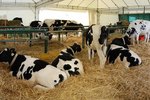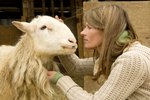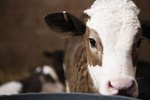The health of a cattle herd depends on the caretaker being able to recognize disease symptoms of common ailments. Many common cattle disease symptoms can be an indication of several different health problems. Sorting the sick cattle and isolating them from the rest of the herd can keep the remaining cattle healthy, even when several display common disease symptoms. Understanding the symptoms can help in making a correct diagnosis to begin an effective treatment.
Appetite Depression

Appetite depression is a common symptom in cattle when their health is at risk. Depression can be recognized by low hanging heads and slow, lethargic movement. The cattle may be slow to come to feed. When feed is in front of them, they may not eat. When moving from one place to another, depressed cattle may hide behind others or be very slow in moving. Because of lack of food intake, cattle may become "slab sided." This is indicated by a slight shaking of their sides when the walk. Caretakers should be around the animals daily and should be able to notice when an animal begins acting depressed.
Cough

Coughing, in a soft, repetitive way can indicate a number of respiratory problems. Cattle will cough from dust to clear their throats, but if the coughing is soft and persistent, it could be a symptom of a serious disease, such as pneumonia. Along with the coughing, an increase in the breathing rate may be noticed.
Runny Nose and Eyes

Fluids running from the nose and eyes of cattle can be an indication of a more serious health problem. Typically the fluid is clear. Cattle lick their faces often with their tongue. When they have runny noses, cattle may not clean their faces as often. These disease symptoms can be an indicator of pneumonia or other respiratory ailments. A dull look to the cattle's eyes can be a symptom of a fever, indicating there is a health issue.
Scours

Scours, as diarrhea is called in cattle, is a symptom of digestive problems or other dangerous diseases. Scours can cause dehydration, which causes weakness. Sunken flanks can be a symptom of dehydration as well as sunken, dull eyes. If fluids are not given immediately, scours can cause death in younger cattle. Scours can be caused by the kinds of food ingested by the cattle. Knowing the cause of the symptom can help in choosing an effective treatment.
References
Resources
Photo Credits
-
Robyn Mackenzie/iStock/Getty Images
Writer Bio
Robyn Nelson has been writing for 25 years, penning articles and ad copy for the motorcycle industry and articles about experiences in her professional career. She played college basketball and received a bachelor's degree in kinesiology from Cal State University at Bakersfield. Nelson has coached many sports and has written articles about team sports.




